75: Early American cards
An overview of some of the early cards made in the United States.
This is an overview of the main stylistic characteristics of early American cards, tracing the connections with English designs and considering innovative versions of the portrait.
Perhaps the most obvious example is the adoption, with a small amount of stylistic adaptation, of the Type I cards of firms who exported to the US like Hart. (References to English designs can be found in my book, Lodge, 2010.) These were the model for what became known in the US as Faro cards, which I designate USType I.
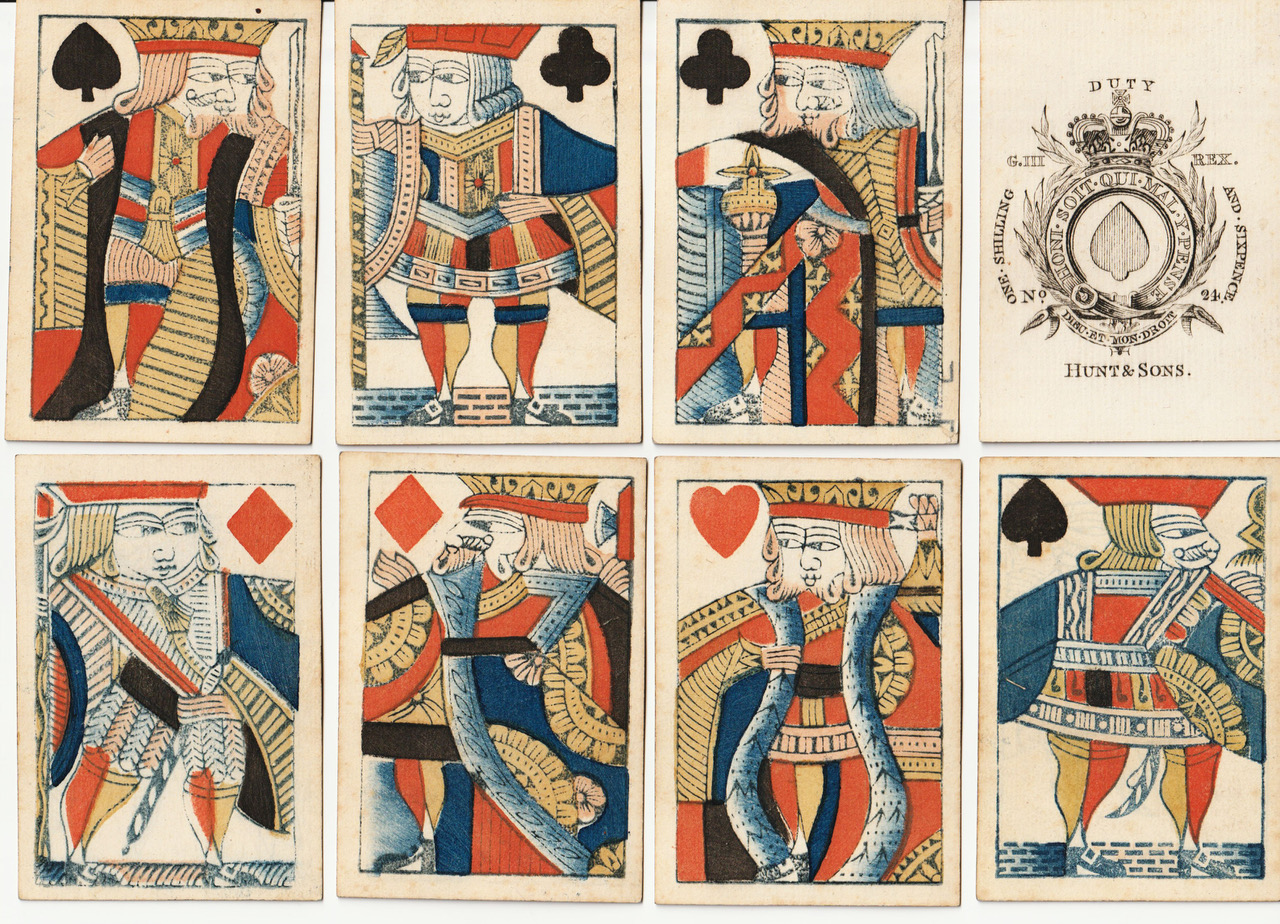
Type I courts in a pack by Hunt
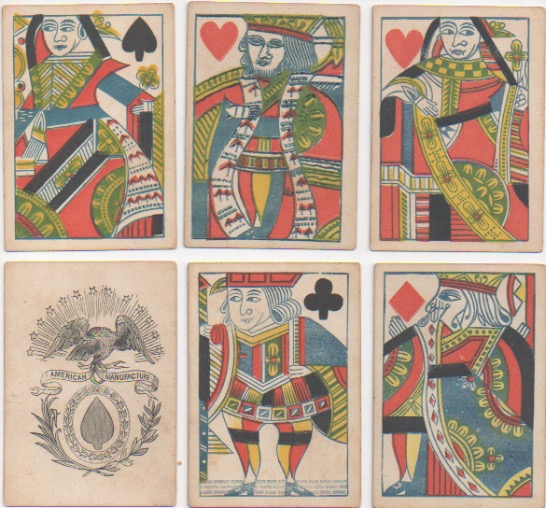
USType I, probably by Crehore
Sometimes the eyes of the QH are looking in opposite directions (!), as in plainbacks I20. The majority of American standard English cards are of this type until the 1830s. However, in 1832 Lewis I. Cohen made his first pack of cards and by 1835 he had installed a new machine for printing all four colours at one impression (see Dawson & Dawson, 2000: 45). These dates are significant in a rather interesting way. Thomas de la Rue also made his first packs in 1832 and he had invented a similar (the same?) process to print cards using letterpress. Furthermore, de la Rue and Cohen were in contact with one another, at least at the level of business, through Thomas’s partner at the time, Jonah Nathan (Houseman, 1968: 68). So there may well have been some co-operation between the two firms. What is clear is that Cohen’s first packs were of the same design as De La Rue’s D2, based on the Type III wood-block courts of the period. I put US in front of the classification of the original design to indicate “derived from/American copy of”.


De La Rue D2; Emporium (could be by Cohen) USD2
In the 1840s there is a kind of hiatus between the old manufacturers such as Thomas Crehore, the Fo(o)rd family and Caleb Bartlett and the later makers who were to become the major players in the US card industry. Many of the latter started in the 1840s (Dougherty, Levy, Samuel Hart), but it was not until the 1850s that they were well established as major firms with a large output. So it would be worthwhile considering some of the trickier issues of identification of packs from this period and to see whether any of the packs from this period that did not have USType I courts display any traits that were to become design features in the later, more widely used designs. It is certainly a period of innovation in design, and some of the courts display very non-traditional features, which suggests that they were drawn by someone with little knowledge of what a set of standard English courts should look like. It is not clear, however, to what extent American card players were as conservative about the cards they used as their English counterparts were reputed to be. In England non-standard features were readily rejected by card-players.
Dawson & Dawson (2000: 9-16) give some valuable background information about this period. Dougherty used the name Crehor (without an e) from 1848 for a few years. Samuel Hart bought some Crehore plates and machinery in 1846, after the Crehore factory was burnt down and the firm went out of business. He also used Crehor aces. At this distance it may seem odd that two firms in competition should use the same pseudonym, though presumably it was to cash in on a well-known name. I think we may safely assume that none of the Crehor aces were used before the demise of the original firm in 1846.
Let’s start with a double-ended pack with a Crehor AS, which shares several characteristics with other packs.
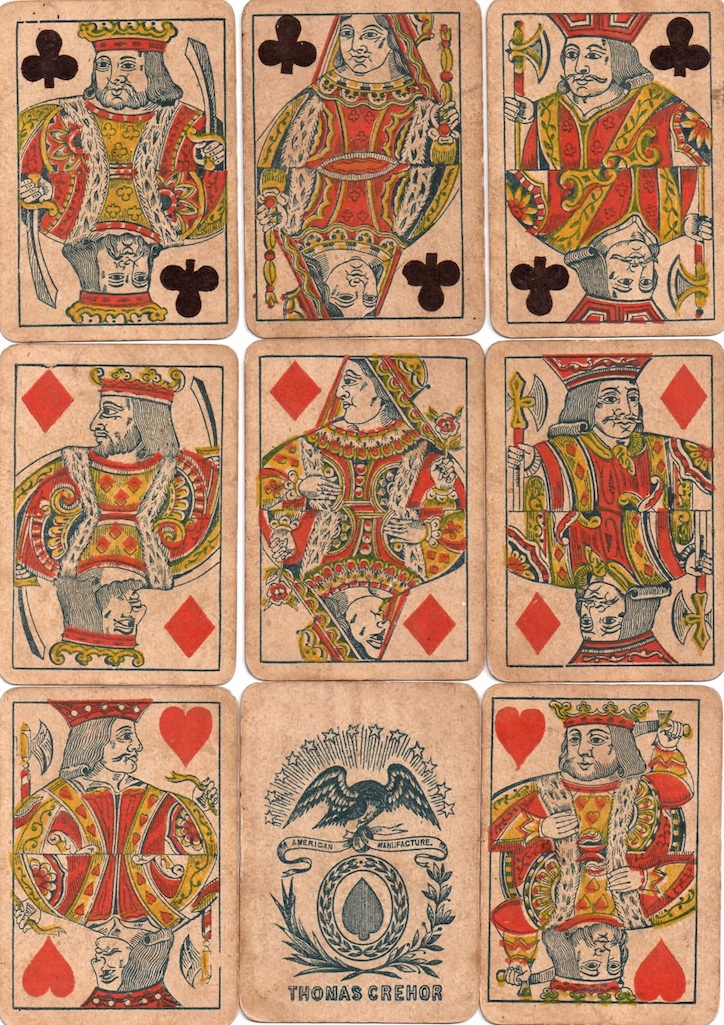

These particular courts are remarkably like those of the first single-figure pack by Dougherty (Hochman AD1). In both cases there are non-traditional features: the QD is in profile and her posture and clothing are quite different from normal, and the JS has a halberd on the left (an intrusive copy of the one on the JH?). The Dougherty JS is holding a leaf, whereas the Crehor one holds the handle of a sword, to which we will return below. Also the colour scheme is the same: no blue except for the grey-blue of the outline plates and ASs. Some of the courts are quite different, but there is enough similarity to make a convincing connection.
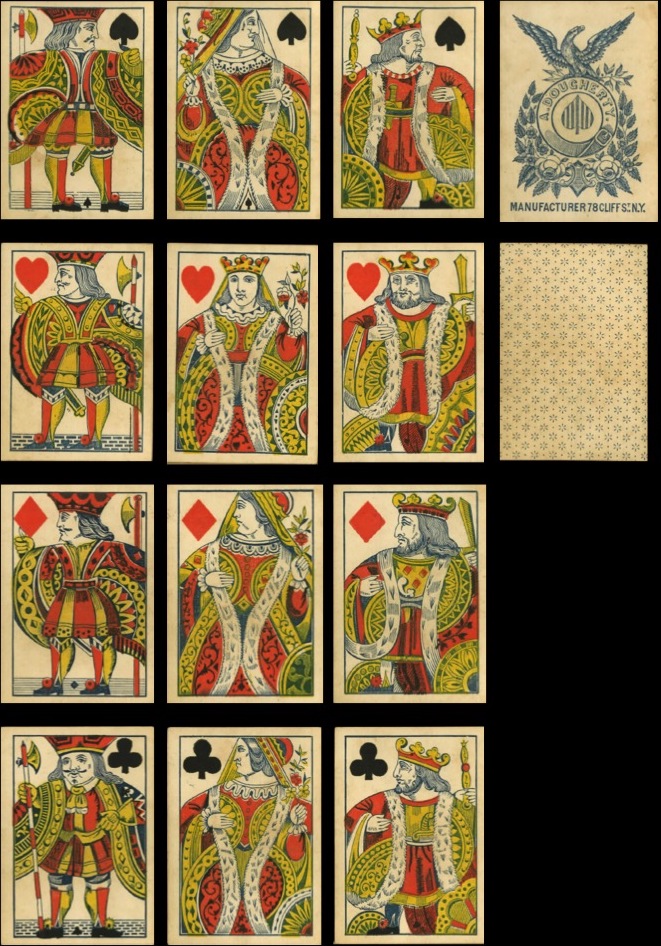
On the KD there are features which are shared with another pack as well, a Charles Bartlet by Hart. The clothing on the Crehor and Dougherty KDs match well; the double-ending has got rid of the hand at the left, to which we will also return. This latter feature, along with a curved sword blade, is found on the Bartlet KD. All three have curly crown decoration.
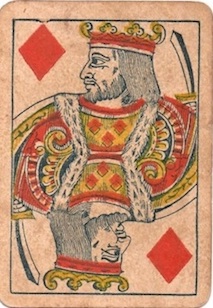

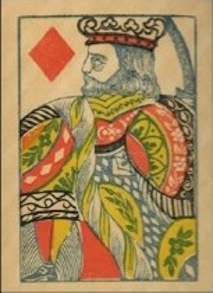
Crehor; Dougherty; Bartlet (Hart)
Curved swords are also shared by the KHs as well as an upward sloping hand on the cloak edge. This time Dougherty’s AD1 does not fit exactly with this pattern, as his sword is held upright, but the KH from a Crehor/Dougherty pack does. This Crehor/Dougherty pack has the courts of AD1a; it is found with the Crehor AS illustrated above or an early Dougherty AS. It must date from c.1848-55. Note that the shared features with this pack concern different courts in the Crehor double-ended pack and the Bartlet one from the ones discussed so far.
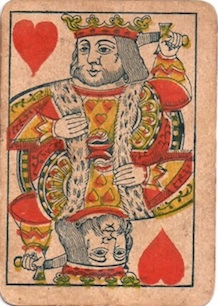
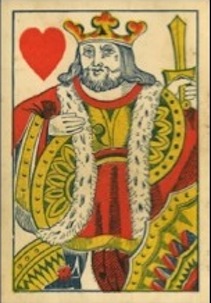
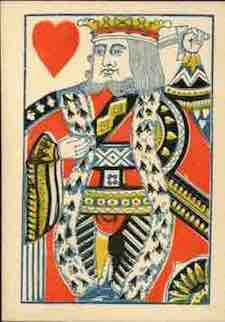
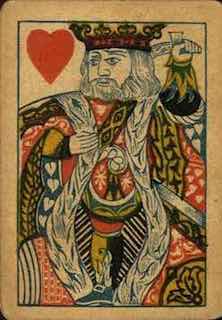
Crehor; Dougherty; Crehor/Dougherty; Bartlet
Note that the facial hair on the Crehor double-ended KH resembles that of the Bartlet KH and the Dougherty single figure; that of the single-figure Crehor/Dougherty pack is quite different, and he has no moustache.
Now we can return to the KD’s missing hand and to other features some of the Crehor/Dougherty courts share with yet another design, which was to become quite widely used in America, though it did not survive the nineteenth century. This is the design designated US8 in Lodge (2010), which is related to the English Whitaker courts (BW1 & BW2) probably made in Belgium. There is a double-ended version, too (US8.1). The earliest example of US8 I can find is by the Congress Card Co., dated 1852 by Hochman (1980), the firm being listed in directories from 1853-55. At about the same time Coughtry & Dougherty used it. By the 1860s it was being used by Lawrence & Cohen, Levy, and Samuel Hart, both in single-figure and double-ended formats, as well as by the Eagle Card Co. of Cincinnati. By the 1880s it seems to have been ousted by other designs. Some of the features of US8 appear to have come from this intermediate period of the 1840s and early 1850s in the packs we have looked at so far, such as the KD having no hand. In US8 the kings have the curly crown decoration that we noted above.


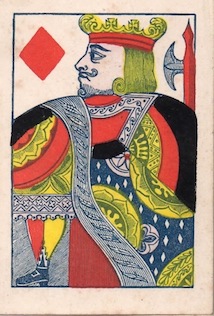
Crehor/Dougherty; Coughtry & Dougherty; Whitaker BW2, c.1850
The QDs have a slight outward curve along the top of the crown, a curved waistline and a squared bodice with dots in each square. The same packs are illustrated.
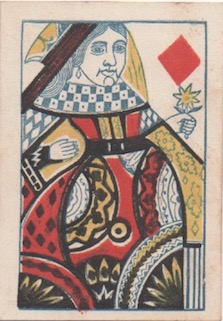
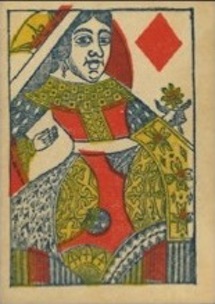
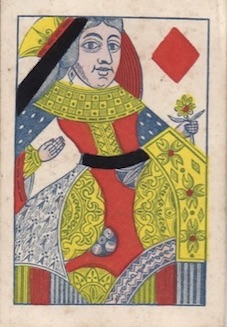
Finally, the spade courts from the same packs have the following shared characteristics: the KS has a straight decoration at the left with diagonal stripes, curled hair at the right and stripes behind his leg; the QS has an elaborate sceptre, a zigzag pattern at the neck and looped hair by her face; the JS holds a sword handle (which we noted above in the double-ended Crehor pack) and a zigzag base to his tunic.
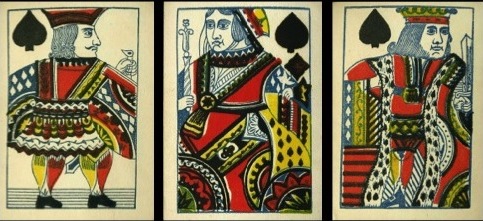 Crehor/Dougherty
Crehor/Dougherty
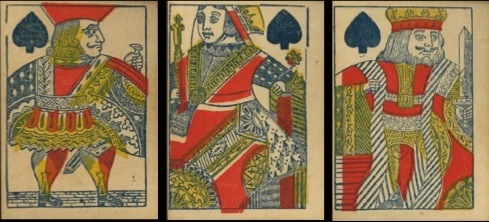 Coughtry & Dougherty
Coughtry & Dougherty

The only other major set of unusual courts of this period is that of Levy. He used USD4.1 courts as well (from De La Rue’s D4.1; see below), but he also had a number of related, redesigned courts, which were not taken up by anyone else. The commonest version is illustrated below.
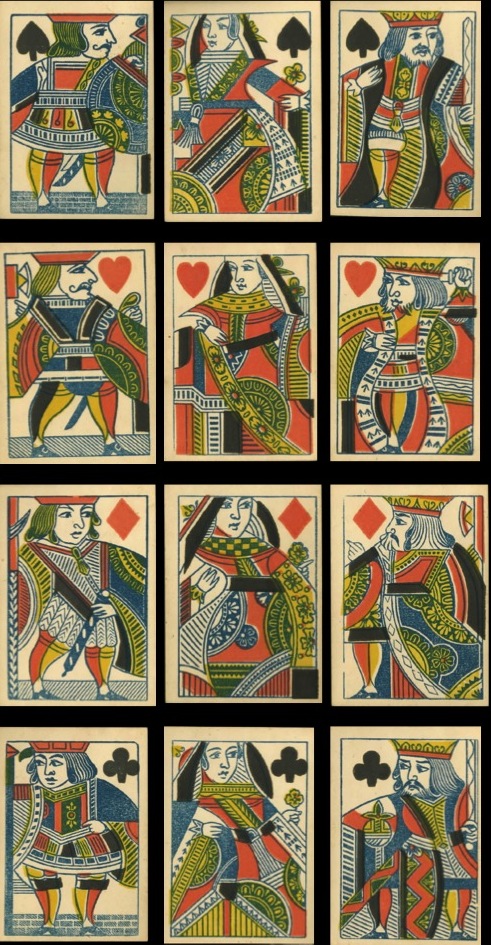
There is a more decorative version with white overlaid curlicues and also a double-ended version with several of the courts changed, e.g. the turned KH with no sword and a flower. Note, too, the spiky moustache on the JC.
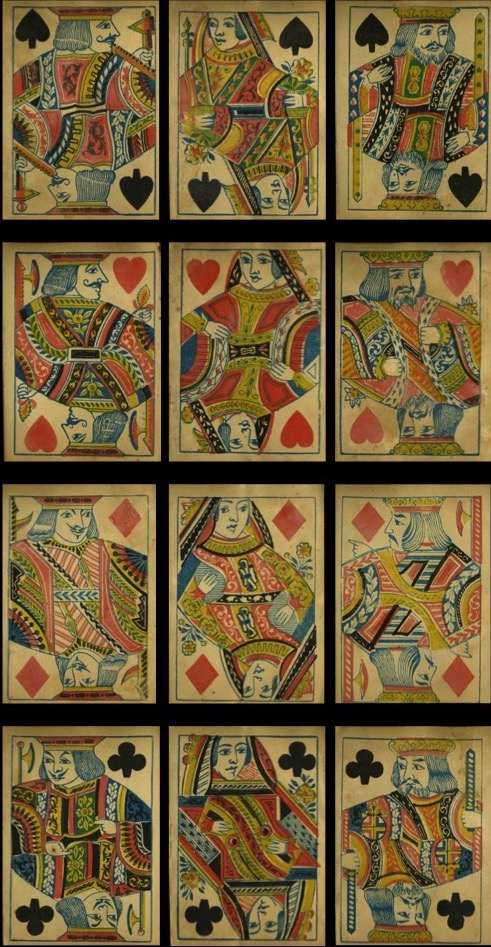
We saw above that De La Rue had an influence on some of the early court cards in the US. His influence on American playing cards continued for some time. He had opened an office in New York in the mid-1850s (Houseman, 1968: 68), so no doubt his cards were known in the US. His design after D2 in England (D3, from c.1845) was a decorative redrawing of the single-figure courts.
 De La Rue D3
De La Rue D3
In this case the closest copy is by Dougherty from c.1855-80. (Whether there was any specific connection between De La Rue and Dougherty I do not know, but Dougherty and Samuel Hart, the inheritor of Cohen, were certainly in competition with one another. I have not been able to find an American collector who knows of any connection, either.)

On the other hand, Cohen’s version of D3 was much less skilfully drawn and has less substantial looking figures; hence it is a much less close copy.
 L.I. Cohen, c.1850
L.I. Cohen, c.1850
The first double-ended De La Rue design to be used as a model is D4.1, used in England from c.1855-65 or a little later. This is based on D3 but redrawn as a double-ended design.
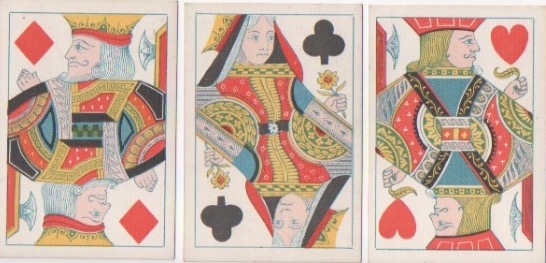 De La Rue D4.1
De La Rue D4.1
Once again Dougherty used this as a model from about 1855, but not so closely as his version of D3, and redrew it several times in a style that became his own.
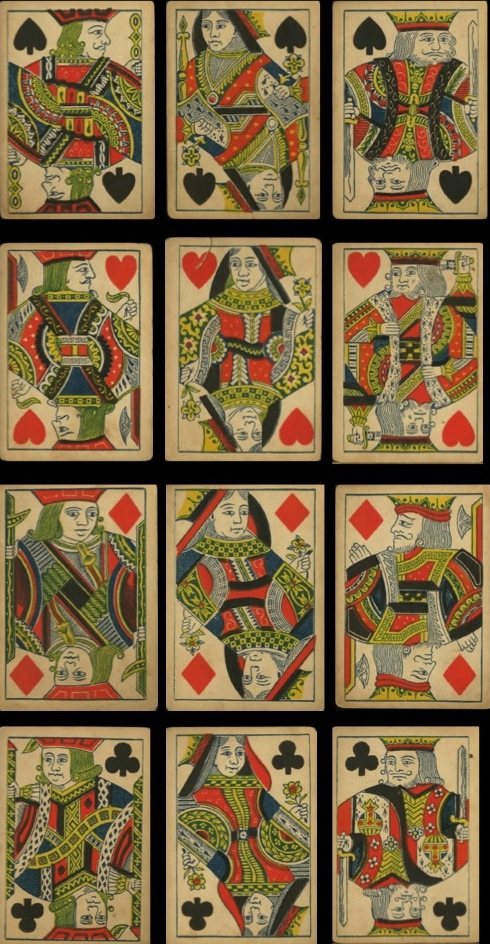 Dougherty USD4.1
Dougherty USD4.1
Later he drew the courts with the same kind of clothing, but the style of the faces was more like that of earlier wood-block courts.
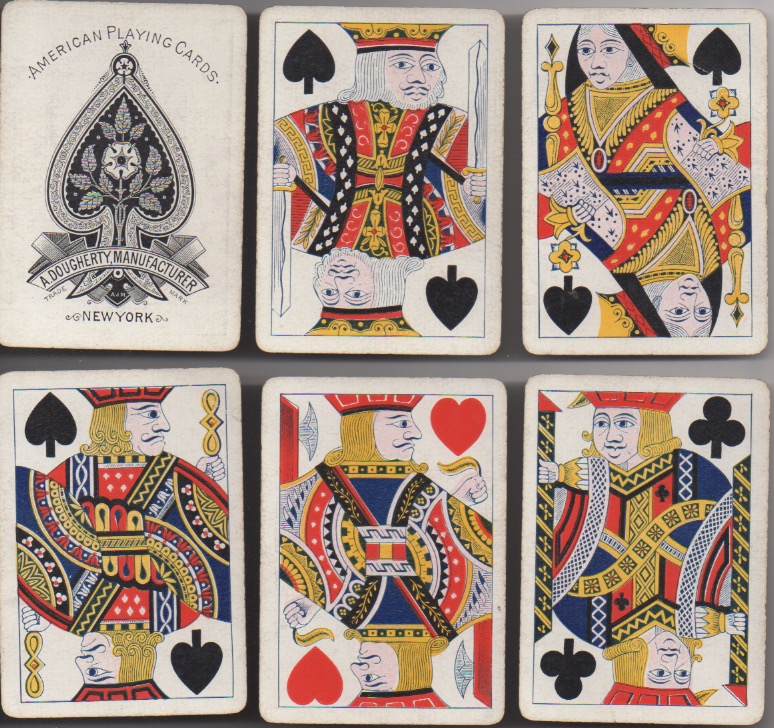
Later still they were redrawn removing the wood-block look and these remained in service with some reduction in size and also redrawn for bridge-width cards up until the 1930s.
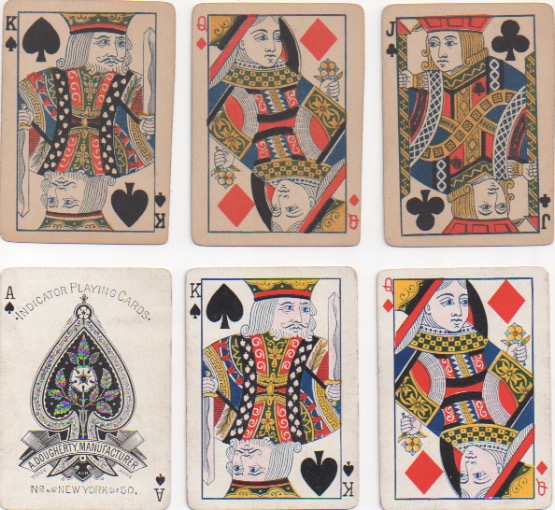
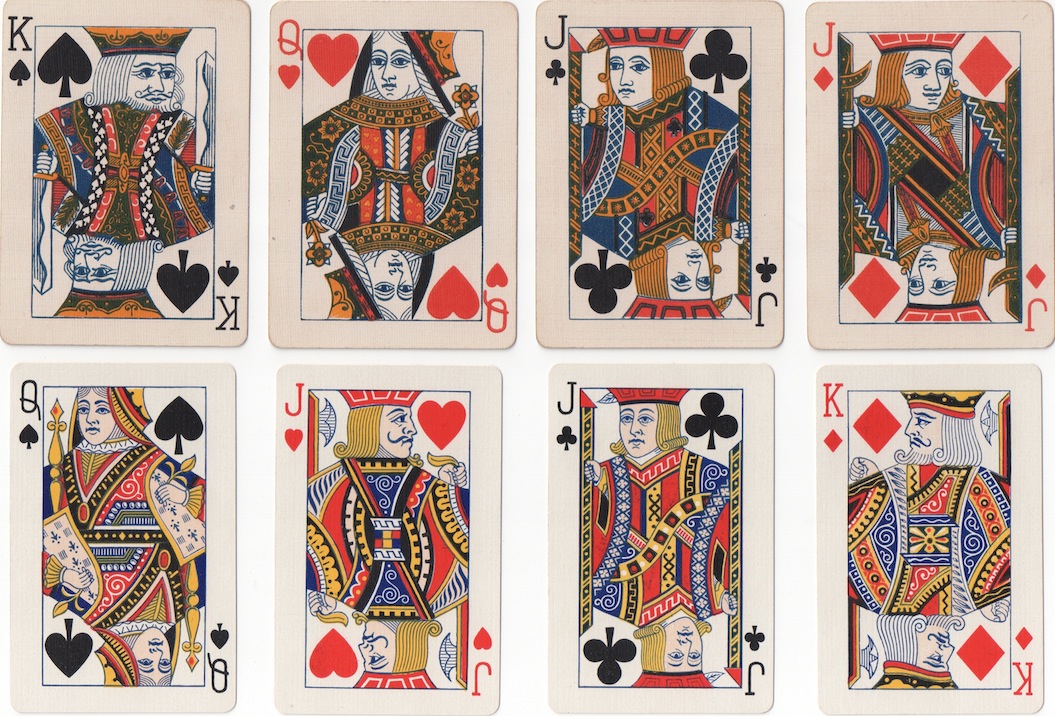
Dougherty wide and bridge width, c.1920
Other copies were made by Levy, less closely modelled on the original design as far as the style of the faces is concerned, and another maker of the NYCC stable, Samuel Hart, in this case with extra white decoration on parts of the clothing.
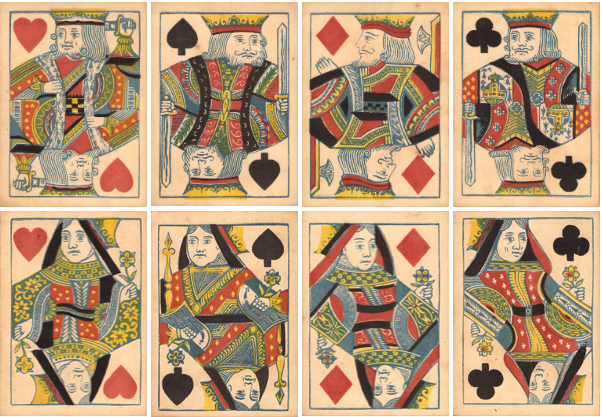 Levy USD4.1
Levy USD4.1
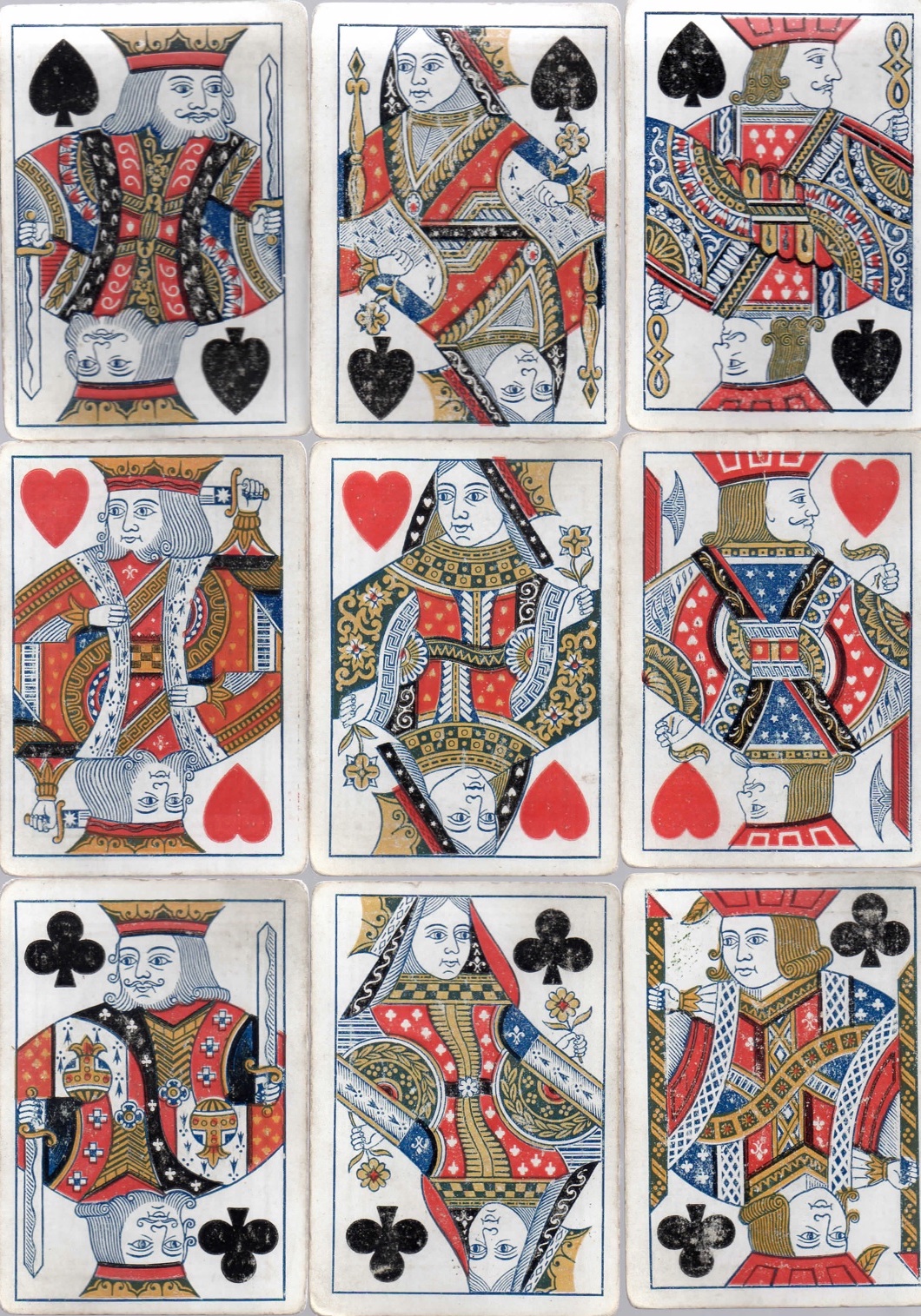 Hart
Hart
De La Rue’s next design, D5, dating from c.1865-72 (overlapping with D6), which has redrawn courts with the same basic clothing, but the crown design is different, was printed for some of the Lawrence & Cohen packs. This was followed by a very close, but redrawn copy.

De La Rue's D5 used in a Lawrence & Cohen pack with an Owen Jones AS, c.1865
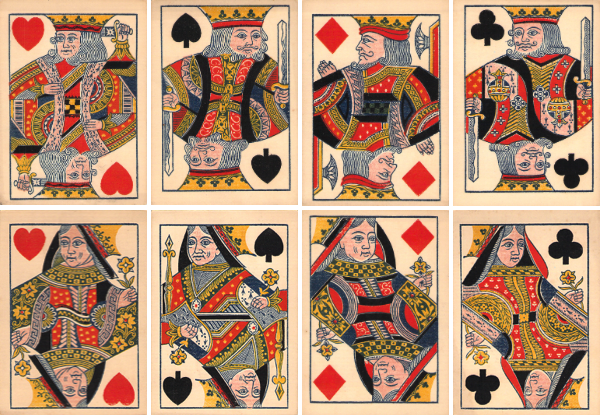
The redrawn version by Lawrence & Cohen, c.1869
The Empire Card Co. and the Union PCCo., members of the large Longley Brothers group of companies (see Dawson & Dawson, 2000: 36), used a redrawn version, which is also very similar to the courts used in later NYCC packs.
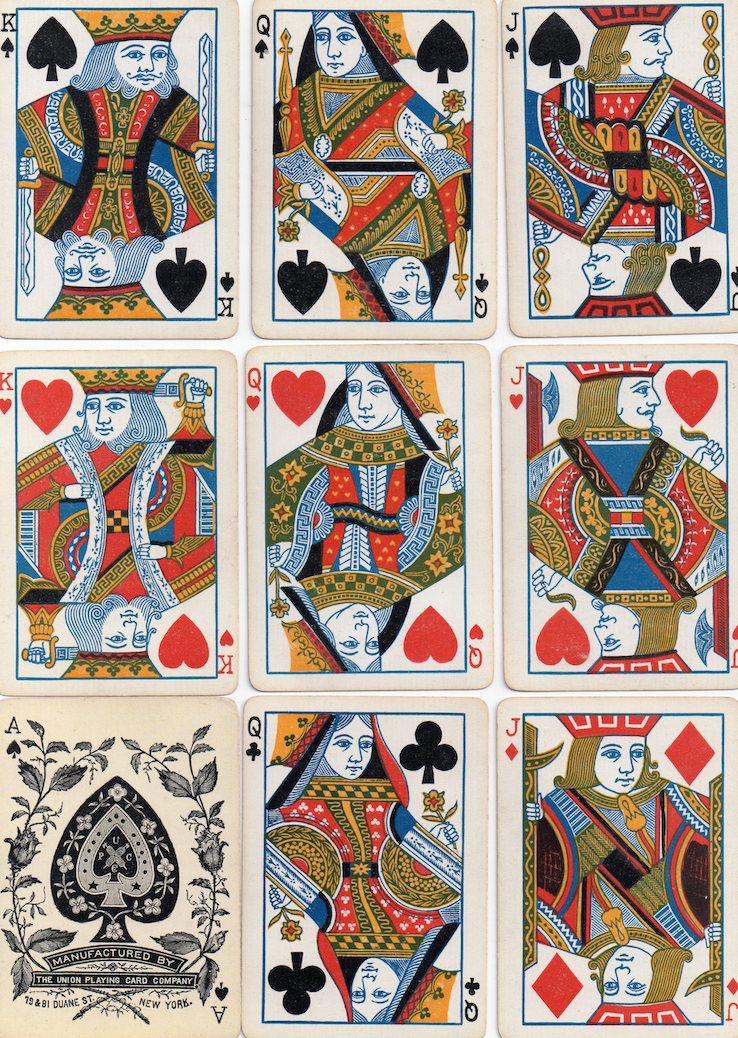
NYCC developed their own style of these courts, which I have designated US6, and produced a version with six turned courts (US6.1), resulting in the ubiquitous, present-day US7, used in most modern USPCC packs and copied widely, especially in China.
 NYCC US6
NYCC US6
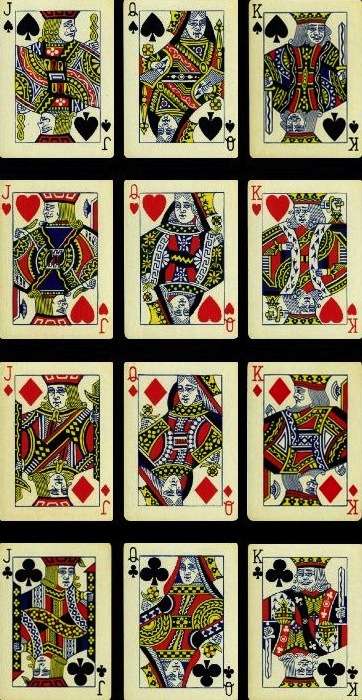 NYCC US6.1 with turned courts
NYCC US6.1 with turned courts
 USPCC US7
USPCC US7
As a final example of the influence of English cards on the US designs we will look at that of Goodall’s G3 and G4. G3 was first imported into the United States by Mauger with a modified AS and with the addition of a joker. For the English market Goodall had used a version with six turned courts, which were redrawn (G4), which is the basis of all subsequent G-designs right up to the present-day version used in Waddington’s No1 packs. The former is also found in Hart packs with redrawn faces and hair. These most likely date from after 1878, the year Mauger sold his business to NYCC and Dougherty. It was also copied by smaller companies, too, such as Eagle Card Co.
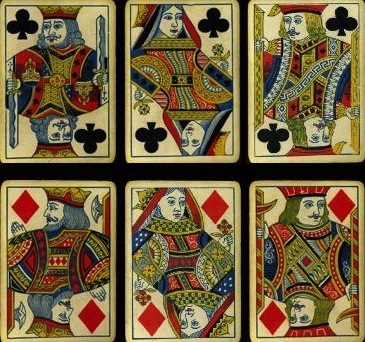 Hart USG3
Hart USG3
 Eagle USG3 from a cassino pack
Eagle USG3 from a cassino pack
G4, with six turned courts, was also imported by Mauger and this, too, was copied by smaller companies such as Knickerbocker and Progress Playing Card Co.
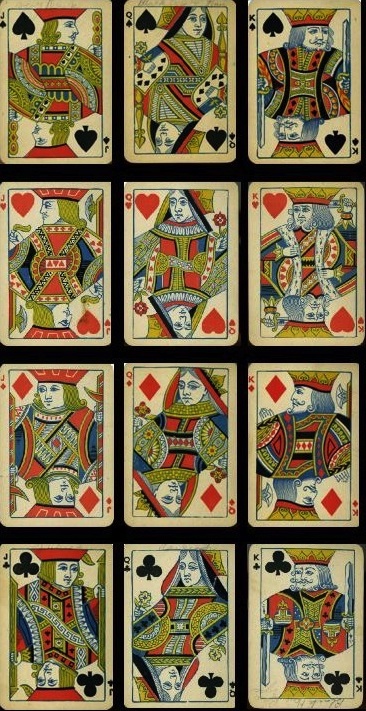 Knickerbocker USG4
Knickerbocker USG4
After Mauger had sold his company, he was employed by the Russell Morgan Co. to set up their playing card department. It is, perhaps, not surprising that there is some resemblance between Goodall’s cards and those of Russell & Morgan. The closest version is in two colours only (US1.2).
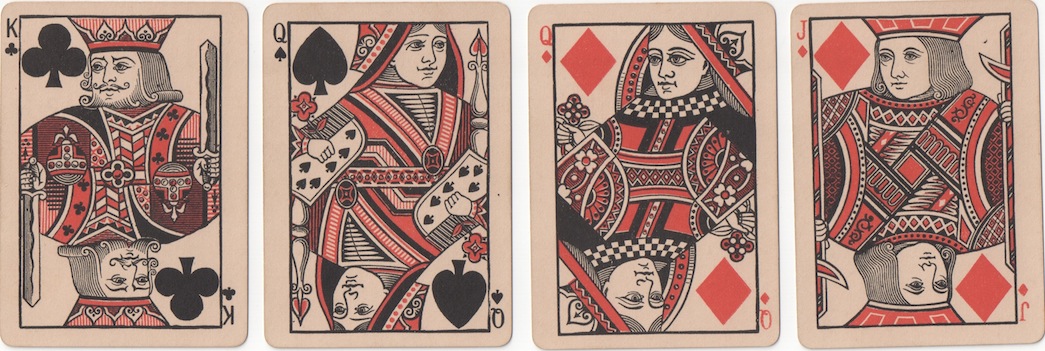
Russell & Morgan US1.2 from a Steamboat pack
In better quality packs the courts were redrawn, especially the KC and JD, thereby obscuring the relationship somewhat. In the case of the JD the head was twisted round in the opposite direction and the clothing completely redesigned.
 Russell & Morgan US1
Russell & Morgan US1
Finally, we have the revised version, US1.1, in which the JD was again redrawn and his head turned back, but the result is not like the Goodall equivalent. It was used in various packs, especially Fauntleroy patience. This version is still in use today in large index packs and has been copied by Copag (now Carta Mundi).
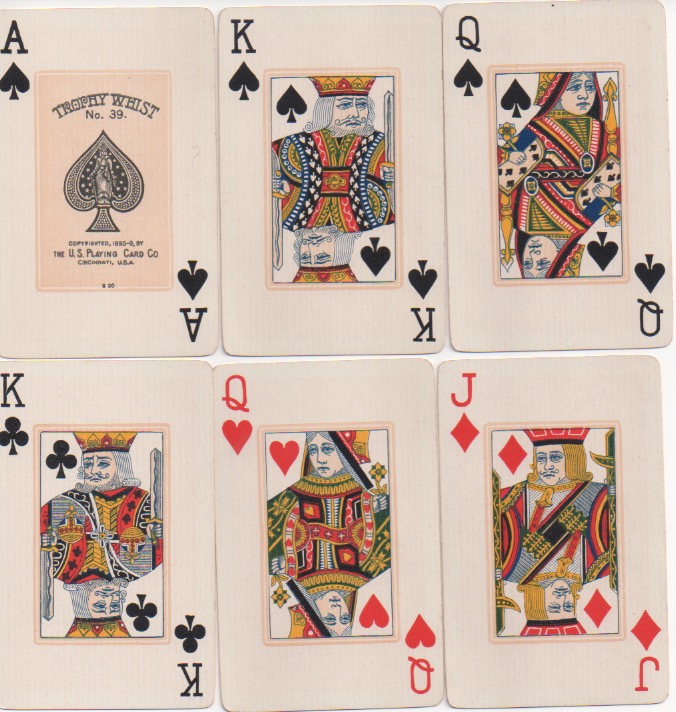 US1.1 from a revised Trophy Whist pack, c.1899
US1.1 from a revised Trophy Whist pack, c.1899
By 1900 the American playing card industry was so well established with the most up-to-date manufacturing technology that American cards became the models for copying, as much as those from England, throughout continental Europe and the rest of the world. After World War II they steadily ousted those from England, until the present day sees only copies and adaptations of American cards all over the place. The only English design left is the somewhat watered down version of Goodall’s (GDW12 & GDW13), which is to be found in No.1 packs and some Chinese packs, too. But nevertheless we should not forget that the origins of a lot of current American designs are from nineteenth century English originals via a long process of adaptation and modernization.
By Ken Lodge
United Kingdom • Member since May 14, 2012 • Contact
I'm Ken Lodge and have been collecting playing cards since I was about eighteen months old (1945). I am also a trained academic, so I can observe and analyze reasonably well. I've applied these analytical techniques over a long period of time to the study of playing cards and have managed to assemble a large amount of information about them, especially those of the standard English pattern. About Ken Lodge →

Leave a Reply
Your Name
Just nowRelated Articles

76: Transitions: Hunt & Sons
Styles change and technology develops. This means that it's possible to see transition periods in th...

Playing Cards: A Secret History
Playing Cards: A Secret History
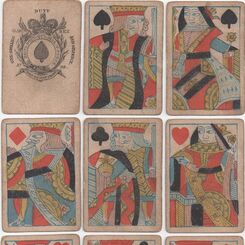
71: Woodblock and stencil: the hearts
A presentation of the main characteristics of the wood-block courts of the heart suit.
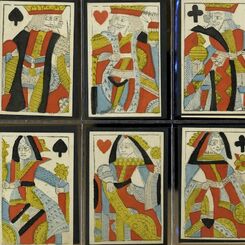
70: Woodblock and stencil : the spade courts
This is a presentation in a more straight forward fashion of the work done by Paul Bostock and me in...
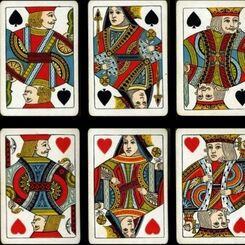
66: Adverts and related material 1862-1900
Some further material relating to cards from nineteenth and twentieth century periodicals.
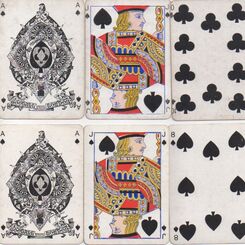
60: Some less common Goodall packs, 1875-95
There are some interesting packs from Goodall in the last quarter of the 19th century.
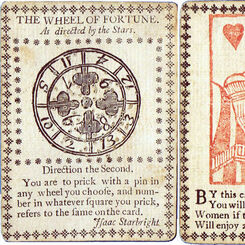
Fortune Telling playing cards
English Fortune Telling cards probably published c.1770.
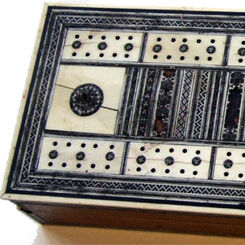
Cribbage Board Collection part 2
A collection of antique and vintage Cribbage Boards by Tony Hall, part 2
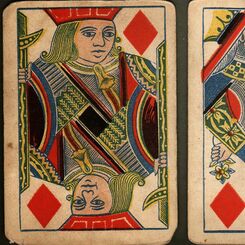
42: Andrew Dougherty
Andrew Dougherty was one of the biggest American card-makers in the 19th century
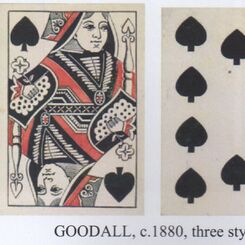
39: Mixed Packs
A number of mixed packs appear for sale from time to time, but it's important to sort out what is me...
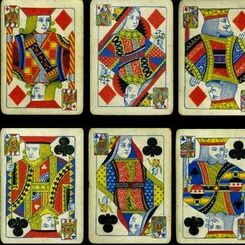
37: Late 19th Century Card-Makers and Problem Cases
After the Old Frizzle period and the tax was reduced to 3d per pack, from 1862 onwards, a number of ...
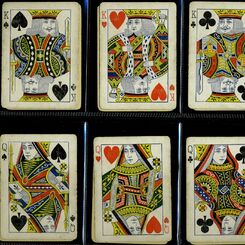
35: More Design Copies
Here I want to take another widely copied design and see how individual variation by the copier can ...
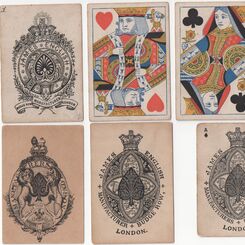
29: James English
An overview of the courts and aces of spades produced by James English
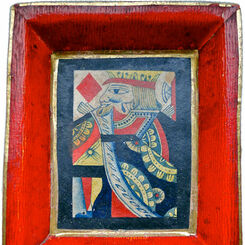
Pope Joan Trays
Some traditional Pope Joan boards comprise a circular tray, others are square, divided into sections...
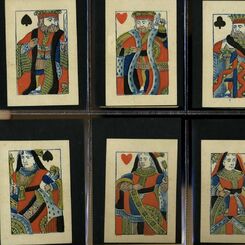
19: 19th Century Breaks with Tradition - Unusual versions of the Standard English Pattern
The centuries-long tradition of English court cards was subject to misinterpretation and in some cas...
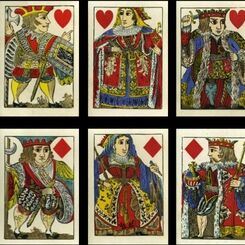
5: De La Rue
In December 1831 Thomas de la Rue was granted his patent for printing playing cards by letterpress.
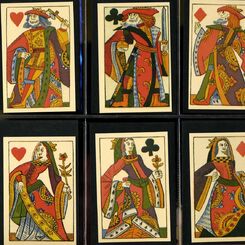
1: Playing Cards and their History: An Introduction and some links to other sites
What was considered the first mention of playing cards in England is in 1463 when Edward I banned th...
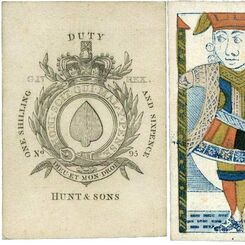
Hunt & Sons, 1820-1849
Hunt & Sons (1820-1849) was the first maker to modernise the court card designs with a complete re-d...
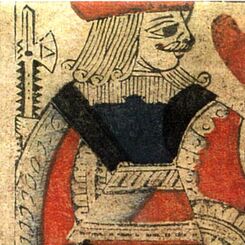
Early English Playing Cards
Early examples of traditional, standard English playing cards of which the best known are those of H...
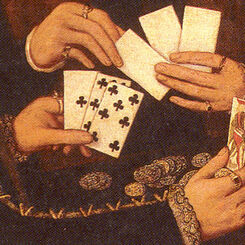
History of English Playing Cards & Games
The History of English Playing Cards dates probably from the mid 15th century
Most Popular
Our top articles from the past 60 days


 Your comment here. Your comment here. Your comment here. Your comment here. Your comment here. Your comment here. Your comment here. Your comment here. Your comment here. Your comment here. Your comment here. Your comment here. Your comment here. Your comment here. Your comment here. Your comment here. Your comment here. Your comment here. Your comment here. Your comment here. Your comment here. Your comment here. Your comment here. Your comment here. Your comment here. Your comment here. Your comment here. Your comment here. Your comment here. Your comment here. Your comment here. Your comment here.
Your comment here. Your comment here. Your comment here. Your comment here. Your comment here. Your comment here. Your comment here. Your comment here. Your comment here. Your comment here. Your comment here. Your comment here. Your comment here. Your comment here. Your comment here. Your comment here. Your comment here. Your comment here. Your comment here. Your comment here. Your comment here. Your comment here. Your comment here. Your comment here. Your comment here. Your comment here. Your comment here. Your comment here. Your comment here. Your comment here. Your comment here. Your comment here.




















